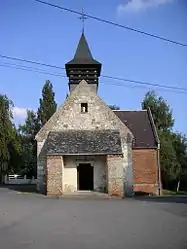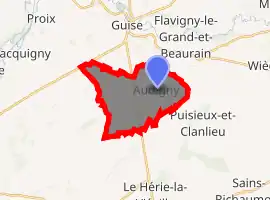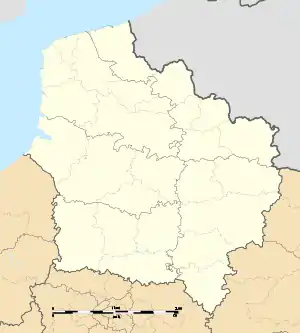Audigny
Audigny is a commune in the department of Aisne in the Hauts-de-France region of northern France.
Audigny | |
|---|---|
 The church of Audigny | |
Location of Audigny 
| |
 Audigny  Audigny | |
| Coordinates: 49°52′14″N 3°38′52″E | |
| Country | France |
| Region | Hauts-de-France |
| Department | Aisne |
| Arrondissement | Vervins |
| Canton | Guise |
| Intercommunality | Thiérache Sambre et Oise |
| Government | |
| • Mayor (2014-2020) | Franck Guiard |
| Area 1 | 10.73 km2 (4.14 sq mi) |
| Population | 279 |
| • Density | 26/km2 (67/sq mi) |
| Time zone | UTC+01:00 (CET) |
| • Summer (DST) | UTC+02:00 (CEST) |
| INSEE/Postal code | 02035 /02120 |
| Elevation | 112–158 m (367–518 ft) (avg. 136 m or 446 ft) |
| 1 French Land Register data, which excludes lakes, ponds, glaciers > 1 km2 (0.386 sq mi or 247 acres) and river estuaries. | |
The inhabitants of the commune are known as Audignois or Audignoises[2]
Geography
Audigny is located some 22 km east of Saint-Quentin and 35 km north of Laon. It can be accessed by the D946 highway from Guise in the north passing through the heart of commune and continuing to Le Hérie-la-Viéville in the south but without passing through Audigny village. The village is reached on road D37 branching south-east off the D946 through the village and continuing south-east to Puisieux-et-Clanlieu. The D586 also passes through the west of the commune from north to south-west. The commune consists entirely of farmland with no other villages or hamlets.[3]
There are no identifiable streams or rivers in the commune.[3]
Neighbouring communes and villages
History

Audigny was known as Aldiniacum in 1065, Aldinisia in 1161, Aldigni in 1165, and Auldigny in 1530. The name comes from a Germanic form of Aldinus derived from the Latin Albus meaning "White".
Albanus (Aldanus) was the name of a saint who lived near London at Verulanium in the 3rd century (now called Saint Albans). A soldier in the army of Diocletian, he returned home to England where he hosted a Christian missionary who was sought by local police. Converted in one night he gave his clothes to the missionary who managed to escape. Shortly after he was arrested for refusing to sacrifice to idols and he was immediately beheaded in 287. His fame and miracles arrived in France where many parishes adopted the saint as protector. His feast day is 22 June - the summer solstice.
The commune land in the 11th century belonged to various religious communities who venerated the saint and gave his name to the hamlet then the parish that was established in the area.
In 1918, after heavy fighting the at Louvry's Farm, the village was liberated on 5 November 1918 at 6:30am by the 70th and 115th Infantry Battalions.
Administration
List of Successive Mayors of Audigny[4]
| From | To | Name | Party | Position |
|---|---|---|---|---|
| 2001 | 2008 | Sylvie Tromelin | ||
| 2008 | Present | Franck Guiard |
(Not all data is known)
Population
| Year | Pop. | ±% |
|---|---|---|
| 2004 | 224 | — |
| 2006 | 240 | +7.1% |
| 2007 | 245 | +2.1% |
| 2008 | 250 | +2.0% |
| 2009 | 255 | +2.0% |
| 2010 | 265 | +3.9% |
| 2011 | 278 | +4.9% |
| 2012 | 283 | +1.8% |
| 2013 | 283 | +0.0% |
| 2014 | 284 | +0.4% |
| 2015 | 282 | −0.7% |
| 2016 | 283 | +0.4% |
Sites and Monuments
- The Château de l'Étang (16th century)
 is registered as an historical monument.[5]
is registered as an historical monument.[5] - The Parish Church of Saint Peter and Saint Paul contains a number of items that are registered as historical objects:
- An Altar Painting: The Resurrection of Christ (1835)
 [6]
[6] - The main Altar, Tabernacle, and Retable (18th century)
 [7]
[7] - A Restoration style Chair (19th century)
 [8]
[8] - A Grotto of Lourdes with statues of the Virgin and Saint Bernadette Soubirous (19th century)
 [9]
[9] - A pair of Stools (19th century)
 [10]
[10] - A Cross: Christ on the Cross (18th century)
 [11]
[11] - A Baptismal font (15th century)
 [12]
[12]
- An Altar Painting: The Resurrection of Christ (1835)
See also
External links
- Audigny on the old National Geographic Institute website (in French)
- Bell Towers website (in French)
- Audigny on Lion1906
- Audigny on Géoportail, National Geographic Institute (IGN) website (in French)
- Audigny on the 1750 Cassini Map
Notes and references
Notes
References
- "Populations légales 2017". INSEE. Retrieved 6 January 2020.
- Inhabitants of Aisne (in French)
- Google Maps
- List of Mayors of France (in French)
- Ministry of Culture, Mérimée PA00115511 Château de l'Étang (in French)
- Ministry of Culture, Palissy IM02002176 Altar Painting: The Resurrection of Christ (in French)
- Ministry of Culture, Palissy IM02002175 Main Altar, Tabernacle, and Retable (in French)
- Ministry of Culture, Palissy IM02002174 Restoration style Chair (in French)
- Ministry of Culture, Palissy IM02002173 Grotto of Lourdes with statues of the Virgin and Saint Bernadette Soubirous (in French)
- Ministry of Culture, Palissy IM02002172 Pair of Stools (in French)
- Ministry of Culture, Palissy IM02002171 Cross: Christ on the Cross (in French)
- Ministry of Culture, Palissy IM02002170 Baptismal font (in French)
| Wikimedia Commons has media related to Audigny. |